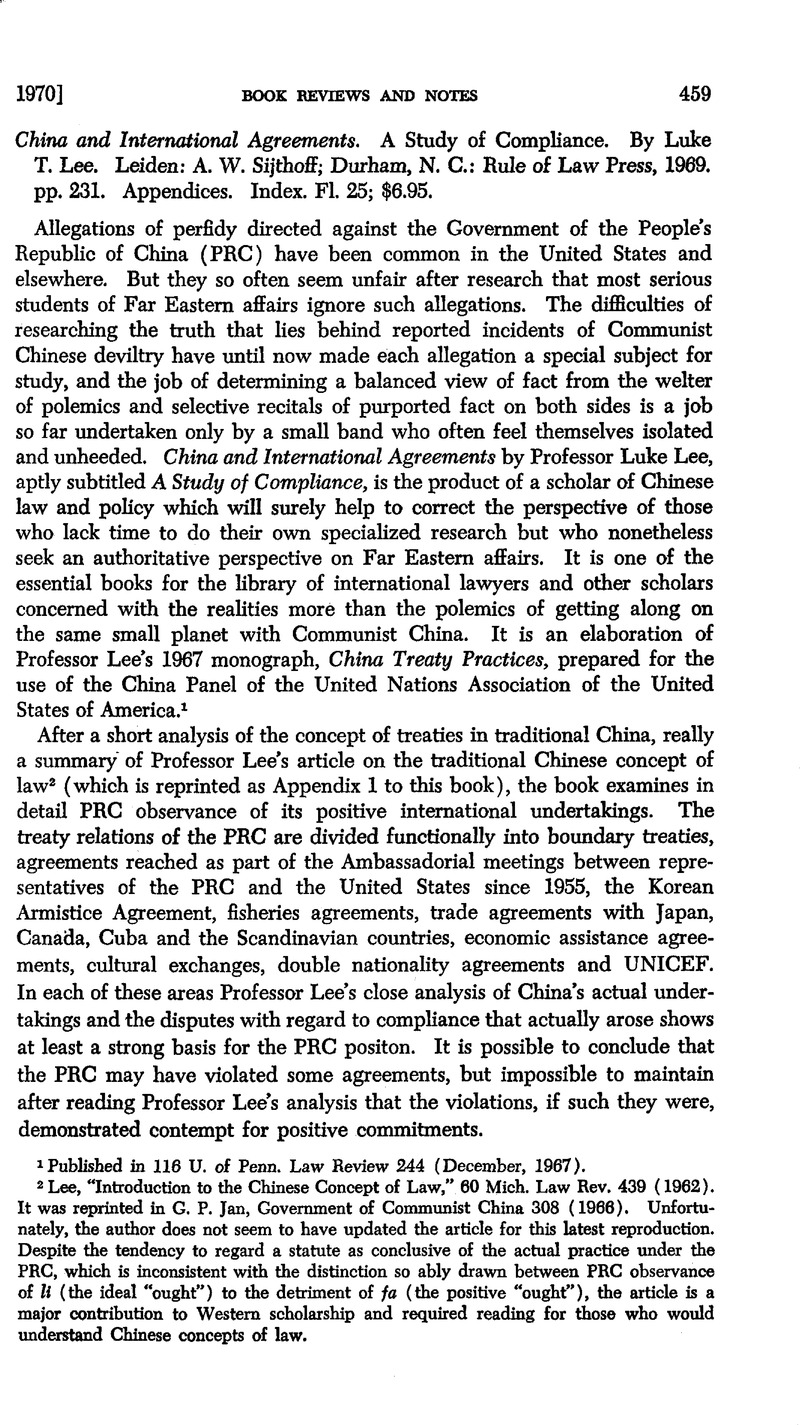No CrossRef data available.
Article contents
China and International Agreements. A Study of Compliance. By Luke T. Lee. Leiden: A. W. Sijthoff; Durham, N. C: Rule of Law Press, 1969. pp. 231. Appendices. Index. Fl. 25; $6.95.
Published online by Cambridge University Press: 28 March 2017
Abstract

- Type
- Book Reviews and Notes
- Information
- Copyright
- Copyright © American Society of International Law 1970
References
1 Published in 116 U. of Penn. Law Review 244 (December, 1967).
2 Lee, , “Introduction to the Chinese Concept of Law,” 60 Mich. Law Rev. 439 (1962)CrossRefGoogle Scholar. It was reprinted in G. P. Jan, Government of Communist China 308 (1966). Unfortunately, the author does not seem to have updated the article for this latest reproduction. Despite the tendency to regard a statute as conclusive of the actual practice under the PRC, which is inconsistent with the distinction so ably drawn between PRC observance of li(the ideal “ought“) to the detriment of fa(the positive “ought“), the article is a major contribution to Western scholarship and required reading for those who would understand Chinese concepts of law.
3 The researcher of China's economic assistance is confronted with irreconcilable assertions such as the following (not cited by Professor Lee specifically but perhaps of interest to the readers of this journal): In an Economic Aid Agreement dated October 7, 1956, China granted Nepal 20 million Indian Rupees and a 40 million Rupee line of credit against Chinese commodities. An additional 100 million Indian Rupees was granted in an Agreement dated March 21, 1960, to be drawn in commodities to be agreed by both Governments. Chinese People's Institute of Foreign Affairs, New Developments in Friendly Relations Between China and Nepal, pp. 15, 25 (Peking, 1960). Hamilton Fish Armstrong reported the 1956 grant of Rupees to be precisely half. Armstrong, “Where India Faces China,” 37 Foreign Affairs 617 at 623 (1959). There is no information available to the public with regard to the total actual delivery of commodities under either agreement. The Colombo Plan Reports of the period are completely silent as to the identity of Nepal's non-Colombo Plan sources of foreign economic assistance. See Sixth, Seventh and Eighth Annual Reports of the Consultative Committee, Cmnd. 315, 610 and 920 respectively (1957, 1958 and 1960).
4 Art. III. This language is mis-cited to Art. IV of the Agreement on p. 34, note 10, of the book.
5 The text of the exchange of notes is in 144 British Foreign and State Papers 640. It would also be interesting to know if in fact any Chinese nationals have been affected by the abrogation of the 1941 agreement. If any substantial rights were renounced by China in purporting to renounce the 1941 agreement, one would expect some Chinese businessmen in Burma to have been hurt. If there have been Chinese nationals forced to relinquish some interest in mining in Lufang, it would be interesting to know whether any of them have been contributors to the Kuomintang Government in Taiwan!


